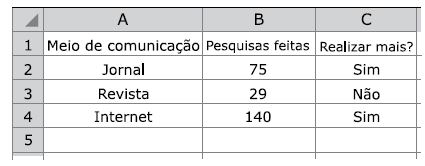Questões de Concurso
Para câmara de mogi mirim - sp
Foram encontradas 90 questões
Resolva questões gratuitamente!
Junte-se a mais de 4 milhões de concurseiros!
Assinale a alternativa que contém o argumento de busca que deve ser utilizado no site.

Assinale a alternativa que apresenta a fórmula que deve estar contida na célula C2, para que esta apresente o valor exibido na imagem.
1 – Digitou uma palavra. 2 – Clicou em alinhar o parágrafo à direita e apertou a tecla Enter. 3 – Digitou uma nova palavra e apertou a tecla Enter. 4 – Clicou em centralizar o parágrafo. 5 – Digitou uma nova palavra e apertou a tecla Enter. 6 – Digitou uma nova palavra e apertou a tecla Enter. 7 – Clicou em justificar o parágrafo. 8 – Digitou uma nova palavra e apertou a tecla Enter.
Após todas as ações executadas, quantos parágrafos ficaram alinhados à direita?
(https://bit.ly/2WgnfKQ. Publicado em 28.10.2019. Adaptado)
Sobre as eleições do Uruguai, é correto afirmar que
(https://glo.bo/33igOIU. Publicado em 05.02.2020. Adaptado)
As críticas se referem
(https://bit.ly/2YkkUOm. Publicado em 13.01.2020. Adaptado)
Sobre a participação do Brasil no Oscar 2020, é correto afirmar:
(https://bit.ly/2QdYXxA. Publicado em 21.01.2020. Adaptado)
Sobre Regina Duarte, em relação ao atual governo, é correto afirmar:
(https://bit.ly/3cXFevG. Publicado em 27.02.2020. Adaptado)
O texto se refere ao conflito
De acordo com a norma-padrão, as lacunas da frase reescrita a partir do cartum devem ser preenchidas, respectivamente, por
Quando mocinhas, elas podiam escrever seus pensamentos e estados d’alma (em prosa e verso) nos diários de capa acetinada com vagas pinturas representando flores ou pombinhos brancos levando um coração no bico. Nos diários mais simples, cromos coloridos de cestinhos floridos ou crianças abraçadas a um cachorro. Depois de casadas, não tinha mais sentido pensar sequer em guardar segredos, que segredo de mulher casada só podia ser bandalheira. Restava o recurso do cadernão do dia a dia, onde, de mistura com os gastos da casa cuidadosamente anotados e somados no fim do mês, elas ousavam escrever alguma lembrança ou uma confissão que se juntava na linha adiante com o preço do pó de café e da cebola.
Quando mocinhas, elas podiam escrever seus pensamentos e estados d’alma (em prosa e verso) nos diários de capa acetinada com vagas pinturas representando flores ou pombinhos brancos levando um coração no bico. Nos diários mais simples, cromos coloridos de cestinhos floridos ou crianças abraçadas a um cachorro. Depois de casadas, não tinha mais sentido pensar sequer em guardar segredos, que segredo de mulher casada só podia ser bandalheira. Restava o recurso do cadernão do dia a dia, onde, de mistura com os gastos da casa cuidadosamente anotados e somados no fim do mês, elas ousavam escrever alguma lembrança ou uma confissão que se juntava na linha adiante com o preço do pó de café e da cebola.
Quando mocinhas, elas podiam escrever seus pensamentos e estados d’alma (em prosa e verso) nos diários de capa acetinada com vagas pinturas representando flores ou pombinhos brancos levando um coração no bico. Nos diários mais simples, cromos coloridos de cestinhos floridos ou crianças abraçadas a um cachorro. Depois de casadas, não tinha mais sentido pensar sequer em guardar segredos, que segredo de mulher casada só podia ser bandalheira. Restava o recurso do cadernão do dia a dia, onde, de mistura com os gastos da casa cuidadosamente anotados e somados no fim do mês, elas ousavam escrever alguma lembrança ou uma confissão que se juntava na linha adiante com o preço do pó de café e da cebola.
